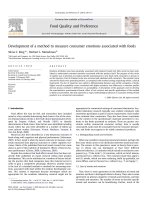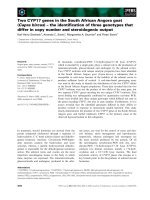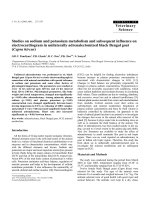Development of connective tissue fibres in pancreas of prenatal stages of goat (Capra hircus)
Bạn đang xem bản rút gọn của tài liệu. Xem và tải ngay bản đầy đủ của tài liệu tại đây (577.96 KB, 6 trang )
Int.J.Curr.Microbiol.App.Sci (2018) 7(7): 2878-2883
International Journal of Current Microbiology and Applied Sciences
ISSN: 2319-7706 Volume 7 Number 07 (2018)
Journal homepage:
Original Research Article
/>
Development of Connective Tissue Fibres in Pancreas of Prenatal
Stages of Goat (Capra hircus)
Dharmendra Singh1*, Ajay Prakash1, M.M. Farooqui1,
Sri Prakash Singh1 and Avnish Kumar Gautam2
1
WBUAFS Kolkata-37, DUVASU Mathura, India
Veterinary Anatomy, Bihar Veterinary College, Patna-14, India
College of Veterinary Science and Animal Husbandry (DUVASU), Mathura-281001, India
2
*Corresponding author
ABSTRACT
Keywords
Connective tissue
fibers, Pancreas,
Prenatal goat
Article Info
Accepted:
20 June 2018
Available Online:
10 July 2018
The present study was conducted on the 24 goat foeti of either sex ranging from 42 days to
full term of gestation. The material was divided into early prenatal (0 to 50 days), mid
prenatal (51 to 100 days) and late prenatal (101 to till term) periods. In all goat foetuses the
pancreas lied in the abdominal cavity partly on right and partly on left side of median
plane. Tissue processing was done with routine histological technique. Up to 59 days
gestation the reticular fibers, collagen fibers and elastic fibers were absent in foetal goat
pancreas. Fine reticular fibers along with fibroblasts were first observed at 69 days of
gestation. From 76 days onwards reticular fibers and fibroblast were more pronounced in
capsule, interlobar and interlobular areas. Moreover, these encircled the tubules, buds,
acini, islets and blood vessels. Beyond this the reticular fibres gradually became coarser
with the increase in age of foetus. Fine collagen fibres having a little bluish tinge were
seen around vicinity of blood vessels at 115 days and distinct fine collagen fibres were
observed at 118 days of gestation. No elastic fibres were observed at any stages of prenatal
goat.
Introduction
The Pancreas is a tubuloalveolar gland
comprises exocrine and endocrine tissues. The
exocrine portion of pancreas which
contributes 95% of pancreatic mass secretes
digestive enzymes into the duodenum and it
includes acinar and duct cells with associated
connective tissue, vessels and nerves. The
endocrine portion of pancreas contributes 12% of pancreatic mass and it synthesizes
insulin, glucagon and somatostatin and
pancreatic polypeptide (Balasundaram, 2018).
The connective tissue fibres viz. collagen
fibres, reticular fibres and elastic fibers play
important
role
in
support
to
the
parenchymatous tissues of pancreas. On
perusal of literature it has been observed that
little attention has been paid towards study of
the pancreas especially during the prenatal
period of goat. Therefore, the present study
has been undertaken to reveal the development
of connective tissue fibres in pancreas of
prenatal goat.
2878
Int.J.Curr.Microbiol.App.Sci (2018) 7(7): 2878-2883
Materials and Methods
The present study was conducted on the
pancreas of 24 foeti procured from healthy
goats (caprahircus) of non descript breed.
Immediately, after collection each foeti was
measured for its crown rump length (CRL) in
centimeters with the help of nylon tape as per
the technique described by Harvey (1959).
The approximate age of foeti was estimated by
using the formula derived by Singh et al.,
(1979) in goat after interpolation of formula of
Hugget and Widdas (1951) in mammals. The
foeti were divided into three groups on the
basis increasing gestational age (Table 1). For
histological studies, the tissue samples were
collected from all the foetuses and fixed in 10
percent Neutral Buffered Formalin. The fixed
tissues were processed through alcoholbenzene- paraffin embedding technique and 56 m thick sections were obtained. The
sections were stained with Wilder’s reticular
stain for reticular fibers, Masson’s trichrome
stain for collagen fibersand Verhoeff’s stain
for elastic fibers (Luna, 1968).
Results and Discussion
At 42 to 44 fetal days of early prenatal period
the primordium of pancreas in goat was found
in close vicinity of the developing duodenum
and abomasum. In few sections it was almost
in apposition to the wall of the duodenum to
which it was connected by the developing
mesentry. Singh and Sethi (2012)reported that
the pancreas of buffalo foetus at 47 days
gestation was suspended in a thin sheet in
mesentery between liver and duodenum. The
reticular, collagen and elastic fibers were
absent in the goat pancreas in early prenatal
period. By 59 days of gestation the collagen,
reticular and elastic fibers were not found in
the mesenchyme of foetal goat pancreas.
However, the sporadic accumulation of
argyrophilic elongated cells was observed in
the peripheral part of mesenchymal tissue at
59 days gestation. However, Conklin (1962) in
man found that in the beginning of foetal
period at 30 mm CR the pancreatic tubules
were enclosed by acidophilic connective tissue
fibers and sparse intertubuler stromal fibers
were argyrophilic.
At 69 days gestation the stroma of developing
goat pancreas consisted of numerous
fibroblasts and mesenchymal cells along with
fine reticular fibers and several congested
blood vessels. At this stage the fibroblasts
were usually present in more than one layer in
the peripheral part of the stromal tissue
whereas, at other places these were scattered
either single or in groups. In the vicinity of the
tubules, buds and developing islets the
fibroblasts were arranged either in the single
layer or more than one concentric layer which
partially or fully encircled these structures.
The reticular fibers were in almost complete
thin layer around the developing pancreatic
mass and formed partial or complete circularly
dispersed sparse network around the tubules,
buds and developing islets of Langerhans. The
network of fine reticular fibers was also
observed between the parenchymal patches.
The collagen and elastic fibers were absent at
this stage (Fig. 1). At 11 to 12.5 weeks
gestation in fetal pancreas of man loose
stroma of argyrophilic fibers were found
between tubules (Conklin, 1962). In 76 day
old goat fetal pancreas thin reticular fibers
encircled the individual tubule and bud and
also around the groups of tubules and buds
into small compartments. The intertubular
fibers remain reticular until end of third month
of gestation in man (Conklin, 1962). Beyond
76 day gestation in all the stages of mid
prenatal period the fibroblasts and reticular
fibers gradually became more pronounced in
the stromal tissue including interlobular and
intra lobular areas. In the late stages of mid
prenatal period dense layers of fibroblasts
along with relatively coarser reticular fibers
were observed in the capsule.
2879
Int.J.Curr.Microbiol.App.Sci (2018) 7(7): 2878-2883
The distinct collagen fibers were absent in
different stages of mid prenatal period,
however, from 87 days gestation very fine
fibers having a little bluish tinge were found in
the stromal tissue which were generally more
pronounced in the vicinity of the blood
vessels. Conklin (1962) in the foetal pancreas
of man reported that the reticular fibers were
the predominant fibers type until about the
eighteenth week of gestation when the fibers
which enclosed the parenchymal elements
acquired the staining characteristics of
collagen fibers. However, Singh and Sethi
(2012) in buffalo found that at 138 days of
gestation collagen and reticular fibers were
well differentiated in the connective tissue
surrounding the acini. The elastic fibers were
absent in the foetal pancreas of goat.
Table.1 Showing the number of goat foeti with their calculated age groups
Groups
I. Early
period
II. Mid
period
III. Late
period
No. of experimental units/
foeti
Age groups
prenatal
6
0 days - 50 days
prenatal
10
51 days - 100 days
prenatal
8
101 days - till full
parturition days of
gestation
Fig.1 Section of 69 days old goat foetal pancreas showing fine reticular fibers in capsule (A)
around tubule (B)
Wilder`s reticular stain×100
2880
Int.J.Curr.Microbiol.App.Sci (2018) 7(7): 2878-2883
Fig.2 Section of 101 days old goat foetal pancreas showing reticular fibers around acini (A)
Wilder`s reticular stain×400
Fig.3 Section of 115 days old goat foetal pancreas showing reticular fibers in capsule (A),
around developing acini (B) and around developed acini (C)
Wilder`s reticular stain×100
Fig.4 Section of 115 days old goat foetal pancreas showing fine collagen fibers around acini (A)
Masson`s trichome stain×400
2881
Int.J.Curr.Microbiol.App.Sci (2018) 7(7): 2878-2883
Fig.5 Section of 118 days old goat foetal pancreas showing collagen fibers around acini (A) and
blood vessel (B)
Masson`s trichome stain×400
In late prenatal period, at 101 days gestation
the stroma of developing goat pancreas had
fine to coarse reticular fibers around the acini,
numerous fibroblasts and few mesenchymal
cells along with congested blood vessels (Fig.
2). The reticular fibers gradually became
coarser in the stromal tissue of capsule,
interlobular and intralobular septa, around the
acini and islets of Langerhans with increase of
the foetal age from 103 to 132 days
gestation(Fig. 3). Distinct collagen fibers
were not found up to 115 days gestation of
late prenatal period. However, very fine
collagen fibres having a little bluish tinge
were seen around the acini (Fig. 4). At 118
days gestation the parenchyma of foetal goat
pancreas was surrounded by a distinct capsule
which had relatively coarser reticular fibers,
fine collagen fibers and numerous fibroblasts.
The septae consisted of fine to coarser
reticular fibers, few fine collagen fibers and
fibroblasts along with numerous free
erythrocytes. By 118 days of gestation
collagen fibers were distinctly observed
around the acini and blood vessel (Fig. 5).
Sujatha et al., (2012) in the pancreas of
human foetus observed that the acini were
arranged into group separated by connective
tissue at the age of 28 to 30 weeks. According
to Gupta et al., (2002) in the foetal pancreas
of man between 24.1 to 30 weeks gestation
the interlobular connective tissue was well
differentiated.
References
Harvey,E.B., 1959. Ageing and foetal
Development. In Reproduction in
domestic Animals. (Eds.) H. Cole and
P.T. Eupps. 1st edn., Vol. I Academic
Press Inc., New York.
Balasundaram, K., 2018.Histomorphology of
pancreas in Goats. Journal of
pharmacognosy and Phytochemistry.
SPI:1711-1713.
Conklin J. A., 1962. Cytogenesis of the
human fetal pancreas. American
Journal of Anatomy.1962; 111: 181193.
Gupta V., Garg K., Raheja S., Chaudhry R.
and Tuli A., 2002. The histogenesis of
islets in the human foetal pancreas. J
Anat. Soc. India 51 (1): 23-26, 2002.
Harvey, E. B., 1959. Ageing and foetal
Development. In Reproduction in
domestic Animals. (Eds.) H. Cole and
P.T.Eupps.1stedn., Vol. I Academic
Press Inc., New York.
Hugget A. St. G. and Widdas, W.F.,1951. The
relationship between mammalian
foetal and conception age. Journal of
Physiology, 114: 306-317.
Luna L. G., 1968.Manual of histological
staining methods of armed forces
institute of pathology. 3rdedn. The
blakistan Division Mc-Graw Hill
2882
Int.J.Curr.Microbiol.App.Sci (2018) 7(7): 2878-2883
Book Company, New Yark.
Singh O. and Sethi R.H., 2012. Histogenesis
of pancreas of Indian buffalo (Bubalus
bubalis) during prenatal development.
Indian Vet. J. 89 (11): 56-59,
November, 2012.
Singh, Y., Sharma, D.N and Dhingra, L.D.,
1979. Morphogenesis of testes in goat.
Indian J Ani Sc, 49(11): 925-931.
Sujatha M., Sugavasi R., Devi I.V., SirishaB.,
Devi S.V. and Suneetha Y., 2012.
Morphometry and histogenesis of
human foetal pancreas. International
journal of health science and research,
December issue.
How to cite this article:
Dharmendra Singh, Ajay Prakash, M.M. Farooqui, Sri Prakash Singh and Avnish Kumar
Gautam. 2018. Development of Connective Tissue Fibres in Pancreas of Prenatal Stages of
Goat (Capra hircus). Int.J.Curr.Microbiol.App.Sci. 7(07): 2878-2883.
doi: />
2883









